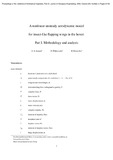- CERES Home
- →
- Cranfield Defence and Security
- →
- Staff publications (CDS)
- →
- View Item
JavaScript is disabled for your browser. Some features of this site may not work without it.
| dc.contributor.author | Ansari, S. A. | - |
| dc.contributor.author | Zbikowski, Rafal | - |
| dc.contributor.author | Knowles, Kevin | - |
| dc.date.accessioned | 2014-01-23T05:01:24Z | |
| dc.date.available | 2014-01-23T05:01:24Z | |
| dc.date.issued | 2006-12-31T00:00:00Z | - |
| dc.identifier.citation | S.A. Ansari, R. Żbikowski, K. Knowles, Non-linear unsteady aerodynamic model for insect-like flapping wings in the hover. Part 1: Methodology and analysis, Proceedings of the Institution of Mechanical Engineers, Part G: Journal of Aerospace Engineering, 2006, Volume 220, Number 2, Pages 61-83. | |
| dc.identifier.issn | 0954-4100 | - |
| dc.identifier.uri | http://dx.doi.org/10.1243/09544100JAERO49 | - |
| dc.identifier.uri | http://dspace.lib.cranfield.ac.uk/handle/1826/8090 | |
| dc.description.abstract | The essence of this two-part paper is the analytical, aerodynamic modelling of insect-like flapping wings in the hover for microair vehicle applications. A key feature of such flapping-wing flows is their unsteadiness and the formation of a leading-edge vortex in addition to the conventional wake shed from the trailing edge. What ensues is a complex interaction between the shed wakes which, in part, determines the forces and moments on the wing. In an attempt to describe such a flow, two-novel coupled, non-linear, wake-integral equations are developed in this first part of the paper, and these form the foundation upon which the rest of the work stands. The circulation-based model thus developed is unsteady and inviscid in nature and essentially two-dimensional. It is converted to a ‘quasi-three-dimensional' model using a blade-element-type method, but with radial chords. The main results from the model are force and moment data for the flapping wing and are derived as part of this article using the method of impulses. These forces and moments have been decomposed into constituent elements. The governing equations developed in the study are exact, but do not have a closed analytic form. Therefore, solutions are found by numerical methods. These are described in the second part of this paper. | en_UK |
| dc.publisher | Professional Engineering Publishing | en_UK |
| dc.title | Non-linear unsteady aerodynamic model for insect-like flapping wings in the hover. Part 1: Methodology and analysis | en_UK |
| dc.type | Article | - |
Files in this item
This item appears in the following Collection(s)
-
Staff publications (CDS) [1209]
